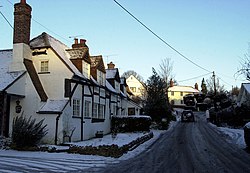South Warnborough
| South Warnborough | |
| Hampshire | |
|---|---|
 Lees Hill, South Warnborough | |
| Location | |
| Grid reference: | SU722474 |
| Location: | 51°13’17"N, 0°58’1"W |
| Data | |
| Post town: | Hook |
| Postcode: | RG29 |
| Dialling code: | 01256 |
| Local Government | |
| Council: | Hart |
| Parliamentary constituency: |
North East Hampshire |
South Warnborough is a small village in Hampshire. The 2001 census recorded a population of 407.
The name of the village derives from "(æt) Weargeburnan", apparently the Old English name for the river Whitewater, meaning "wolf stream".[1]
The village is in the east of the county, three miles south of the village of Odiham and six miles north of Alton. It is in the valley of the River Whitewater as it rises to the North Downs. The undulating countryside is unspoilt and the village contains old brick and half-timbered cottages, many under thatch.
The parish has a pub, The Poacher, a popular village shop and Post Office, Street Farm House, a beautiful Jacobean guest house, a 12/13th century Norman Church, and a playground. In the centre of the village is The Ridley Hall, a small village hall.
Contents
Church
The church, St Andrew's, was given by William the Conqueror to Hugh fitzBaldric. The church dates from the early 12th century. Its walls are made of flint rubble, except for the west wall of the nave and the 19th century south aisle. Its roofs are now tiled, though in the Middle Ages they may well have been thatched.
The unusual wooden bell turret at the west end is late 14th century. Inside, the roofs of the nave and chancel are of the trussed-rafter type, used in mediæval and late mediæval times. In its original form the church had no south aisle: this was added by a Victorian restoration about 1870.
The south aisle was built in the 19th century, but there is to the right of its communion table an early 12th century volute capital and shaft possibly of the same date as the nave walls. On the window behind the altar are represented the three feathers of Wales twice and the Tudor Rose once, probably for Prince Arthur, the elder brother of Henry VIII, and also the emblems of Katherine of Aragon who stayed at Dogmersfield when she first arrived in England to marry Arthur.
History
South Warnborough is recorded as Wergeborne in the Domesday Book. The translation for the Victoria County History of Hampshire runs as follows:
In Odingetone (Hoddington) Hundred:
The same Hugh holds Wergeborne and Guy (de Craon holds it) of him with his daughter. Bondi held it of King Edward. It was then assessed at 11 hides; now at 6 hides. There is land for 12 ploughs. In demesne are 2 ploughs and (there are) 15 villeins and 16 bordars with 6 ploughs. There are a church and 3 serfs, and a mill worth ten shillings, and 12 acres of meadow. T.R.E. (in the time of King Edward) it was worth 12 pounds, and afterwards 6 pounds; and now 10 pounds[2]
In the book Church, Manor, Plough – Volume 1 of the History of South Warnborough written by John Simpson in 1946, he details a statement made on 28 September 1822 by William Cobbett who was passing through the parish on one of his 'Rural Rides' from Odiham to Winchester:
We have come over roads and lanes of flint and chalk. The weather being dry again, the ground under you, as solid as iron, makes a great rattling with the horses feet. The country where the soil is stiff loam upon chalk, is never bad for corn. Not rich, but never poor. There is at no time anything deserving to be called dirt in the roads. The buildings last a long time, from the absence of fogs and also the absence of humidity in the ground. The absence of dirt makes the people habitually cleanly; and all along through this country the people appear in general to be very neat. It is a country for sheep, which are always good and sound...[2]
At the Norman Conquest, William the Conqueror granted the manor of Wergeborne (South Warnborough) to one of his great Norman barons, Hugh fitzBaldric. Hugh gave the manor and the living of St. Andrew's Church which went with it, to his daughter on her marriage to Guy de Craon. Their son Alan, grandson Maurice and great-grandson Guy continued as lords of the manor but the living of St Andrew's, with land and woods, was granted by Alan to Freiston Priory, a sub-cell of the renowned Crowland Abbey in Lincolnshire, in which county the de Craons also had lands.
Elizabeth I came to South Warnborough from Basing House on 21 September 1601 and dined with Richard White (d. 1613). She knighted him, and made his wife a lady in waiting.[3]
Events
The village fête is usually the centrepoint of the Village in June–July.
A television advertisement for Ambrosia Devon Custard was filmed in the field where the village fête is currently held, taking advantage of the view it provides over the centre of the village including the church.
Outside links
| ("Wikimedia Commons" has material about South Warnborough) |
- A History of the County of Hampshire - Volume 3 pp 378-382: Parishes: South Warnborough (Victoria County History)
References
- ↑ Ekwall, Eilert, The Concise Oxford Dictionary of English Place-Names. Oxford, Oxford University Press, 4th edition, 1960. p. . 498 ISBN 0198691033
- ↑ 2.0 2.1 Simpson, John (1946). Church, Manor, Plough. Winchester.
- ↑ John S. Brewer, Court of King James, vol. 2 (London, 1839), pp. 20-23.
